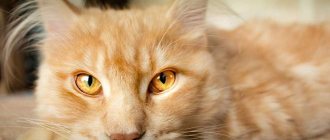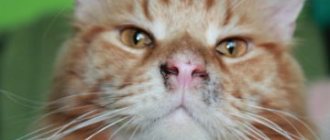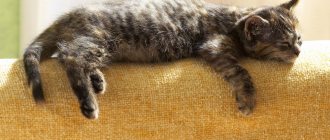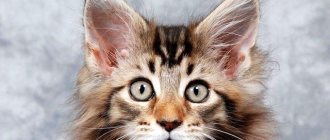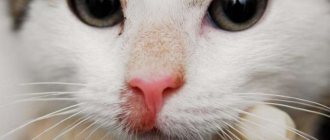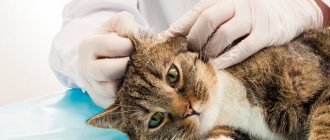What to pay attention to
The formation of the film is preceded by the appearance of signs that cannot be ignored.
Tearing, white veil
Increased lacrimation can develop from infections, after injuries, or from a foreign object.
A white veil on the organ of vision appears due to weight loss, dehydration, and oncological processes. This is the third eyelid, which droops with adenoma, exophthalmos, enophthalmos .
Signs of pathology
When a white veil covers the floor of the eye, they speak of prolapse of the third eyelid. In a normal state, its movement is invisible to prying eyes. The eyelid cleans the surface of the apple and produces a third of the tear fluid.
When the gland protrudes, the following symptoms are observed:
formation of a reddish clot in the inner corner of the eye;- profuse lacrimation;
- redness of the edge of the apple;
- development of conjunctivitis.
If the condition is advanced, pus is released from the corners of the eyes, the mucous membrane swells, the animal squints, and the eyelids become swollen.
Diagnostics
With such a symptom, the pet’s visual apparatus should be examined by a doctor.
If a film appears on the cat’s eyes and the whites are half closed, it is necessary to urgently show the pet to the veterinarian. The doctor will conduct an initial examination, ask the owner about the symptoms that appear, and try to find out the causes of the disorder. If the third eyelid is closed due to inflammatory processes, a smear from the mucous membrane is taken to determine the pathogen. When a pathological growth appears in the corner of the eye, the doctor will take a sample for a biopsy to rule out malignant processes. If the eye begins to squint and moves too far to the side, an MRI of the brain is prescribed.
White film growth
The third eyelid in a healthy cat is visible only when blinking, in a state of sleep.
Importance for a cat
The formation protects the cornea from dust, debris, plant thorns, etc., evenly distributes the secretion of the lacrimal gland, and protects the surface of the eye from drying out.
Reasons for sinking
An increase in film size can be associated with both external and internal factors.
There are several reasons for the development of a pathological condition:
- bacterial, viral, fungal infections;
- failure of internal organs;
- exhaustion, dehydration;
hormonal imbalance;- entry of foreign bodies;
- oncology;
- weakening of the ligaments and muscles of the eye;
- helminthiasis;
- injuries;
- allergic conjunctivitis;
- atrophy of the eyeball.
British and Persian cats are more susceptible to the development of vision pathologies due to the structural features of the skull. Regardless of other reasons, genetic predisposition is a fundamental factor in the occurrence of the disease.
Signs of adenoma
This is a benign formation. It is characterized by the appearance of a small tumor that prevents the eyes from closing completely.
Symptoms:
increased body temperature;- purulent discharge from the eyes;
- photophobia;
- neoplasms in the corners of the eyes;
- loss of appetite;
- irritability.
The animal also continuously washes itself, squints, and blinks.
Associated symptoms
If the cause of the adenoma is systemic diseases, the following signs of ill health are observed: vomiting, diarrhea, weakness, decreased activity, weight loss, deterioration in coat quality.
Diagnosis of eye diseases in cats
Diarrhea in a cat: how to treat it at home
If this misfortune has befallen your pet, you should immediately consult a veterinarian. The organ of vision is examined and its general condition is assessed according to three parameters:
- appearance of the eyeball and surrounding tissues;
- general condition: size, shape, presence of injuries;
- state of vision.
After a superficial diagnosis, a study is carried out using special devices. The fundus of the eye is examined, the sensitivity of the microflora to antibiotics is determined, and the pressure inside is measured. A specialist may prescribe a biochemical blood and urine test.
Fundus examination by a veterinarian
First aid
Self-medication in this case is strictly prohibited. Medicines are used only after consultation with a veterinarian. If you delay in going to the clinic, your pet’s condition will quickly deteriorate.
As soon as the owner notices that his pet has a white film on the organ of vision, and an urgent visit to the veterinarian is impossible, the animal is treated at home.
Wiping the eyelids
Take a clean cotton cloth, moisten it with warm filtered water, and carefully remove all discharge from the eyes from the outer corner to the inner one.
Moisturizing the eyes
If the eye is swollen, carefully spread the eyelids and drip saline solution. If the film falls out, periodically moisten the eye with saline solution and apply a sterile bandage.
Help with bleeding
If bleeding occurs, apply a sterile bandage or gauze folded in several layers to the eye (the material should not stick). When soiled, the bandage is changed, but at least once a day.
Examination by a veterinarian
At the clinic, the doctor conducts a full examination of the pet. An ophthalmoscope is used to examine the condition of the fundus.
If there are no injuries, clinical tests are prescribed.
Third eyelid on both eyes
If the film is only on one of the eyes, then the reason for this is most likely a foreign body that caused a reaction in the eye. And if such a third eyelid appears on two eyes of a pet at once, then this is already a sign of the appearance of various serious diseases. Various eye problems in cats occur due to injury or infectious disease. Severe, severe injuries often appear in cats after fights, and problems with the cornea of the eye often arise because of this. Infected claw wounds are terrible in themselves, although it will be even worse if a dangerous infection gets into the wound, as this can lead to severe complications.
Most often, such wounds after a cat fight will cause the formation of acute keratitis and a creeping, terrible corneal ulcer.
Because of this, the cat's eye will first become cloudy and erosion will form on its surface with fairly pitted common edges. Further, your pet may develop white or greenish discharge; this is a very dangerous phenomenon that requires the intervention of a veterinarian who has good experience in this matter. It is required to carefully and as often as possible monitor the behavior of the animal, and if symptoms of the disease appear and if the cat behaves strangely, you must immediately go to a veterinary hospital. It is also recommended to feed your pet more and better, giving him vitamin B12 daily.
A thorn in ophthalmic diseases
A white spot on the eye can appear in cats with other pathologies. All of them are characterized by a severe course and threaten the pet with disability:
- glaucoma is the most severe disease in domestic cats in terms of course and complexity of treatment;
erosion of the cornea of the eye develops due to mechanical injuries, burns, viral and bacterial diseases;- infectious processes caused by bacteria, viruses, fungi cause clouding of the cornea.
There are a number of diseases that affect the eyeball, which leads to the development of leukoma.
Causes and symptoms
There are several reasons why a film appears on the eyes of cats. The primary option is associated with a speck or other foreign body getting into the pet’s eye. This can cause swelling and minor inflammation. If the foreign object is not pulled out, this can lead to new growths in the mucous membrane of the eye, while the white film serves as a kind of protection against emerging infection.
The second option for the reason for the appearance of a blockage in the eyes of an animal is an infectious disease. This usually applies to ailments that are infectious in nature. Inaction in this case will subsequently lead to complete blindness of the cat and damage to nearby organs.
Cat with kitten
Among the diseases that cause a transparent film to appear on a cat’s eye are the following:
- the presence of parasites in the body;
- conjunctivitis;
- diseases of organs, especially the stomach and intestines, in which external symptoms appear in the form of eye damage;
- bacterial infections;
- mechanical eye damage, trauma;
- common purely eye diseases - cataracts, strabismus, damage to the vascular system that supplies the organs of vision.
Determining the true cause of the appearance of film on a cat’s eyes can only be done with the help of high-quality diagnostics, which should be carried out in laboratory conditions.
Treatment
Therapy is prescribed depending on the diagnosis. Surgical and conservative treatment methods are used.
A small tumor is removed surgically without affecting the membrane itself. A large tumor is excised along with the film, and the animal is at risk of blindness.
Injuries are treated conservatively if they are shallow. Such wounds in cats heal quickly.
The injured nictitating membrane is sutured, then antibiotics are prescribed.
For inflammation due to bacterial infection, broad-spectrum antibiotics are prescribed in the form of drops and ointments.
For fungal diseases, fungicidal ointments are used.
Vitamins, minerals, nutrients, and immunomodulators are prescribed as additional treatment.
Preventive measures
To protect the tailed creature and minimize the occurrence of problems with the visual apparatus, you should do the following:
- plan a cat’s diet - it must be balanced and consist of quality products;
- do not forget about additional vitamins in the cat’s menu;
- periodically rinse your cat's eyes with Furacilin (1 tablet per 100 g of water);
- use potassium permanganate for preventive purposes;
- regularly examine the eyes of the mustachioed creature and monitor changes in its behavior;
- do not forget to free your pet from roommates - worms, fleas, etc.
- Take your pet to the veterinary clinic for examinations at least once a year.
If you notice slight redness of the mucous membrane and tearing, use Tricilin powder on the affected areas.
Eye diseases in cats are not such a rare occurrence; a number of such diseases can be cured by the cat’s owner on their own. Although the ideal option is to seek help from a veterinarian, which must be done in almost all cases.
Prevention
Each pet needs to be provided with proper care: a balanced diet, regular hygiene procedures. Timely vaccination is important to keep your pet healthy.
It is not recommended to let your domestic cat outside; contact with stray animals is undesirable.
Timely deworming is the key to good health for your pet. The procedure is performed on kittens and adult animals.
